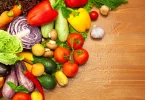The CDC reports that only 1 in 10 adults get enough fruits or vegetables daily.
Eating a diet rich in fruits and vegetables is essential for your overall health. Studies show fruits and vegetables can help lower the risk of cardiovascular disease, type 2 diabetes, cancer, and help with overall weight management. Yet, we all know how it can feel incredibly difficult to incorporate the right number of fruits and vegetables consistently each day.
In this article, we will highlight some of the key benefits of fruits and veggies, as well as cover 6 essential ways you can incorporate more fruits and vegetables into your daily diet. Keep reading to learn all about the power of produce!
The Benefits of Adding More Fruits & Veggies to Your Diet
According to the Heart & Stroke Foundation, the recommended daily serving of fruits and vegetables is between 7 to 10 servings for teens and adults, and between 4 to 6 servings for children. The foundation further states that one serving of fruits and vegetables can be defined as:
- ½ cup of fresh, frozen, or canned veggies
- ½ cup of cooked leafy greens
- 1 cup of raw leafy greens
- 1 whole fruit (apple, orange, etc.)
- ½ cup of frozen or canned fruit
- ½ cup of 100% fruit juice
The reason behind these hefty daily servings is that fruit and veggies offer you a ton of health benefits that are essential for body and brain function, disease prevention, and more.
Here is a breakdown of 5 of the key health benefits that come from fruits and vegetables:
- Great Source of Nutrients: Fruits and vegetables are easily one of the best sources of vitamins, minerals, and essential nutrients. Each fruit and veggie come with its own set of nutrients, making it fun to mix and match according to your needs.
- Disease Prevention: Eating your daily serving of fruits and veggies can significantly help in terms of disease prevention, including type 2 diabetes, stroke, heart disease, and high blood pressure. Plus, fruits and veggies also help to boost your overall immune health!
- Digestive Function: Dietary fiber is one of the key nutrients found in almost all fruits and vegetables. Fiber is crucial in any diet, as it both helps keep you feeling full after a meal and assists in proper digestive function. It is important to know that symptoms of lack of fiber can include constipation and bloating.
- Low in Calories: Even for heftier fruits and veggies, the caloric content of these foods is relatively compared to denser and more processed foods. This makes fruits and veggies a fantastic option for people trying to maintain a healthy weight.
- Improved Mental Health: Studies have shown that proper intake of fruits and vegetables helps to provide a positive influence on mental health in adults.
Without further ado, let’s discuss the 6 ways you can easily add more fruits and veggies to your diet:

1. Start with Breakfast
Breakfast is the most important meal of the day!
This morning meal provides you with the energy you need to start your day on a positive note – and luckily, there are many simple ways you can incorporate fruits and veggies into your breakfast, including:
- Adding dried or fresh fruits to porridge and cereal
- Smoothie bowl using blueberries, strawberries, and other rich antioxidents
- Creating savory breakfasts with grilled tomatoes, mushrooms, and beans
- Meal-prepping the night before using fruits and veggies as a main ingredient, thus cutting down on your morning preparation duties
2. Attack Snacks at Midday
What’s a good day without your daily snacks?
Snacks provide us with a needed energy boost between meals and keep us in good spirits as we complete our day’s work. Plus, snack time is one the easiest and best times to sub out processed foods for a sweet fruit treat or savory veggie snack.
Here are some great ideas for fruit and veggies to add to your snack repertoire:
- Veggie chips
- Dried fruits (Dried mango is a great source of Vitamin C!)
- Chopped veggies with hummus
- Fruit salads (Use Greek yogurt as a base for your fruit salad for an added source of protein)
- Kale chips (You can make these at home with a bit of olive oil, a pinch of salt, and an oven!)
3. Pack a Healthy Lunch
Need lunch on-the-go? Vegetables make an awesome base ingredient for all kinds of packed lunches.
From salads to soups, there are many tasty options when it comes to creating a healthy lunch. Salads offer plenty of opportunities to add extra vegetables, while soups can be great vehicles for beans and pulses.
Having a fruit and veggie-packed lunch is an excellent way to keep your energy levels high when the mid-day blues come to get you. Here are some of our favorite lunch ideas that include fruits and veggies:
- Greek salads with cucumbers, banana peppers, onions, chickpeas, tomatoes, and feta
- Veggie and hummus wrap with your favorite crunchy vegetables
- Rice bowls topped with roasted vegetables
- Bean soups or chilis with a variety of beans and leafy greens
- Whole fruits as a side (Rather than sodium-packed potato chips!)
4. Sip on a Smoothie
When you need to meet your fruit and veggie quota for the day, what better way to do so than with a delicious smoothie?
Smoothies are a great opportunity to mix in bananas, strawberries, blueberries, and more to help you reach your daily serving of fruits. Plus, you can add in greens as well – like spinach or kale – to give your smoothie an extra health boost masked by delightful fruity flavors.
5. Plan Your Dinners
The day is done and it’s finally time for the last meal of the day – dinner. When you’re home from work and in rest mode, it can feel difficult to expend more energy and effort on your evening meal – thus, we highly recommend planning ahead of time.
With the proper meal planning, you can ensure your dinners are full of nutritious fruits and vegetables. You can even meal prep your dinners so they are ready to go when you get hungry!
6. Eat the Rainbow
When seeking to add more fruits and veggies to your diet, it is important to remember to eat the rainbow.
Fruits and veggies come in all colors and shapes, each with its own benefits to your health and wellness. Below, we have broken down each fruit and veggie color, including examples of foods and the benefits they provide:
Red Fruits & Vegetables
Red fruits and vegetables are a fantastic source of antioxidants that help to reduce the risk of medical conditions such as high cholesterol and hypertension. Additionally, they are super helpful when it comes to improving brain function.
Examples of red fruits and veggies include:
- Strawberries
- Apples
- Tomatoes
- Rhubarb
- Raspberries
- Cranberries
- Beets
• Orange Fruits & Vegetables
Orange fruits and vegetables provide you with a healthy dose of Vitamin C, a vitamin that is essential for boosting your immune health and protecting your cells from free radicals. Plus, Vitamin C is a necessary nutrient for the growth and repair of body tissue.
Examples of orange fruits and veggies include:
- Citrus (Oranges, Tangerines, Grapefruit, etc.)
- Carrots
- Sweet Potatoes
- Mangos
- Pumpkin
- Papaya
Yellow Fruits & Vegetables
Yellow fruits and vegetables are most well-known for their ability to maintain skin health, promote eye health, and prevent certain diseases (such as heart disease). These fruits and veggies also tend to be packed with vitamins A, B6, and C, as well as essential nutrients such as magnesium and potassium.
Examples of yellow fruits and veggies include:
- Bananas
- Corn
- Squash
- Pineapple
- Lemon
- Yellow Zucchini
Green Fruits & Vegetables
Along with typically being one of the best sources of dietary fiber, green fruits and vegetables help maintain your bone health and vision. Dark green vegetables are also an excellent source of powerful and highly-concentrated antioxidants that boost immune health, reduce inflammation, and more!
Examples of green fruits and veggies include:
- Bell Peppers
- Leafy Greens (Kale, Spinach, Bok Choy, etc.)
- Cruciferous Greens (Broccoli, Cabbage, Brussel Sprouts, etc.)
- Avocado
- Asparagus
- Lime
- Green Pears
- Peas
Purple Fruits & Vegetables
Purple fruits and vegetables gain their color from anthocyanins, a powerful type of flavonoid that offers important antioxidant effects. Some of the key benefits of purple fruits and veggies include improved brain health, lowered inflammation, and disease prevention.
Examples of purple fruits and veggies include:
- Blackberries
- Eggplant
- Passion Fruit
- Purple Potatoes
- Purple Cauliflower
- Plums
- Grapes
- Honorable Mention: Blueberries – though technically blue in color, this fruit is often lumped in with its purple companions.
Final Thoughts
Eating your daily serving of fruits and veggies is incredibly important for not just your health but also your overall well-being.
Try out some of the meal and snack ideas above, or get creative and come up with your own fun recipes that incorporate more fruits and veggies. And remember – eat the rainbow!
Author’s Bio:
Vickie Chin is the Social Media & Brand Manager at Organic Traditions – a leading brand of functional superfood products, on a mission to make it easier for people to incorporate superfood nutrition into everyday life.








